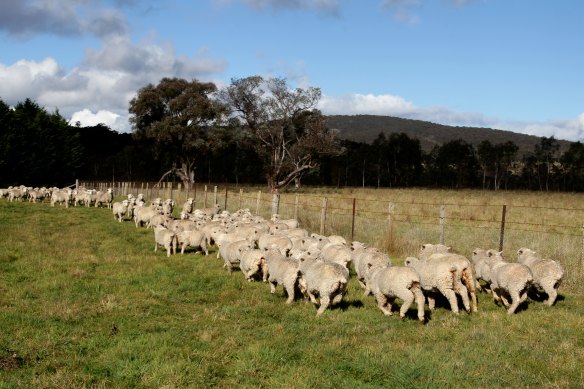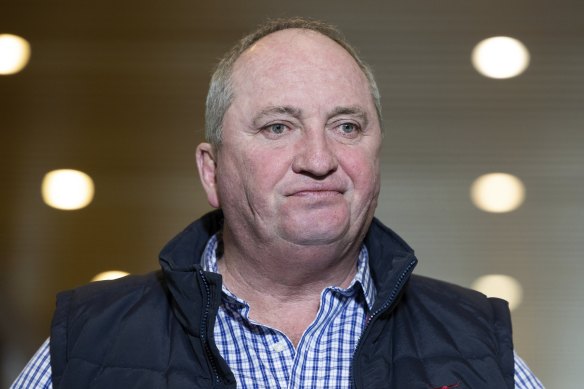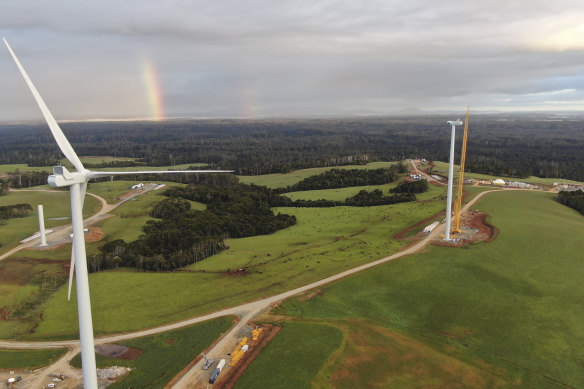Doug Landfear, the Californian-born Australian project director of Danish renewable energy giant Vestas, confesses he does not know exactly what federal Nationals MP Barnaby Joyce meant when he described the company’s environmental impact statement for a NSW wind farm proposal as “nothing but a pack of poo-tickets”, but he guessed it was not good, and says he is not entirely surprised.
“Barnaby has a certain way of speaking,” Landfear says.
A plan to build a massive wind farm near Walcha is causing division in the community. Some say it will provide a reliable stream of income insulated from drought and flood, while others believe the turbines would spoil prime productive land.Credit:Dallas Kilponen
At issue is a plan to build a massive wind farm to the north and east of Walcha, a village of 3000 or so on the crossroads of Thunderbolts Way and the Oxley Highway in the NSW Northern Tablelands.
The project could have serious implications on whether the state – and indeed the nation – might achieve its goal of shifting rapidly to renewable energy.
Walcha lies within the NSW government’s New England Renewable Energy Zone.
Under the state government’s energy plan, in such zones, renewable energy projects will be supported and linked to the grid to replace ageing coal plants as they are decommissioned.
Former Nationals leader Barnaby Joyce described Vestas’ environmental impact statement for a NSW wind farm proposal as “nothing but a pack of poo-tickets”.Credit:Alex Ellinghausen
The policy is causing divisions in some communities where there are disagreements over whether the income generated by new renewables is worth the impact on the landscape.
And Vestas is offering the people of Walcha a staggering amount of money.
Should the so-called Winterbourne Wind project go ahead, about 55 landholders stand to earn about $30,000 per turbine hosted on their land a year. Some could have up to 10 turbines. Vesta has also entered into negotiations with some neighbours who would be in sight of the towers for further payments.
Total investment in the region would be about $1 billion over the life of the project.
The Granville Harbour Wind Farm in Tasmania. Should the Walcha project go ahead 119 towers would be built in all, making the project the largest in the nation.
These would not be small towers. They would stand about 149 metres high at their hub and 230 metres at the tips of their blades – about 30 metres shorter than Sydney’s new Crown Casino.
Should the project go ahead, 119 towers would be built in all, making the project the largest in the nation at present, generating enough electricity to power 375,000 NSW homes.
The local council stands to benefit too, as Vestas is offering to pay $1 million upfront and $750,000 a year, indexed to the CPI, for the life of the project.
Over 25 years this could see the tiny council take in up to $35 million, and would be, as far as Landfear is aware, the largest community benefit payment ever made for a such a project in Australia.
Joyce’s colourful line against the environmental impact statement provided by Vestas was made during a public meeting held by opponents of the project at Walcha’s bowling club last month. He dismisses the payment.
“That wouldn’t even pay for a roundabout,” he told the Herald and The Age.
He said the community should oppose the wind turbines and that state and federal governments should co-operate to extend the life of the coal power stations until a new wave of nuclear energy technology, known as small modular reactors, is available.
Proponents of these machines say they will provide abundant clean and cheap power. Sceptics note they do not yet exist commercially and that nuclear power remains the most expensive source of energy on earth, while solar and wind are cheap and declining in cost.
The benefits of the Winterbourne scheme have convinced grazier Ted Fenwicke, whose family has farmed in the region for five generations.
He describes a reliable stream of income insulated from drought and flood as the “holy grail” that would help his family build and improve their core businesses.
He rejects the argument of some of his neighbours that the turbines would spoil prime productive land, because, he notes, the turbines would be built on his land’s rocky ridge-lines where wind is strongest.
He believes the roads Vestas would build to install and maintain the turbines would be to his family’s benefit as well. “If they can get a 100 tonne truck up there, it is going to be better than anything we can build,” he says.
But he is aware of the tension the project is causing. His children, who will inherit the land, have embraced the project. His brother does so with far more reservation.
“The first time you look at a picture [of a turbine] you think, ‘Wow, that’s a pretty wild piece of equipment,’” he says. “But I’m sure people were pretty confronted the first time they saw a big powerline too.”
By Landfear’s count of the 948 public submissions made regarding the Winterbourne project, 498 are in support and 438 are opposed. Another 12 are simply comments.
Joyce remains unrepentant for opposing the project and the potential windfall for his community.
“We would end up with more man-made structures over 230 metres in height than Sydney CBD,” he says.
Besides, he says, many of those who support projects like this live in the inner suburbs of Sydney and Melbourne.
“Well, if you support them, why don’t you support building them in your area rather than in ours?” he asks.
“This idea that we can just have wind towers built everywhere and that is going to be the solution is patently absurd,” he said.
His position puts him at odds not only with some of his constituents, but with his colleague, NSW Treasurer Matt Kean, whose policy on both climate and energy depends on such development.
Asked if he was concerned about tension over the Walcha project, Kean said in a statement that renewable energy plans were expected to attract at least $32 billion in private investment and support more than 9100 jobs in regional NSW and provide $1.5 billion in lease payments to farmers.
“This is a once-in-a-generation opportunity to diversify local economies, create jobs and create new, stable revenue streams for farmers, even during tough times.
“Local communities will see a range of benefits from being part of a renewable energy zone, irrespective of whether they host a project or not. This includes a requirement for all developers to contribute up to $1700 per megawatt of their project to a new community benefit fund, which will be invested in local projects.
“The NSW government expects all renewable energy projects to undertake genuine and extensive consultation with local communities, with all projects subject to a rigorous planning assessment.”
A guide to the environment, what’s happening to it, what’s being done about it and what it means for the future. Sign up to our fortnightly Clear Air newsletter here.
Most Viewed in Environment
From our partners
Source: Read Full Article



